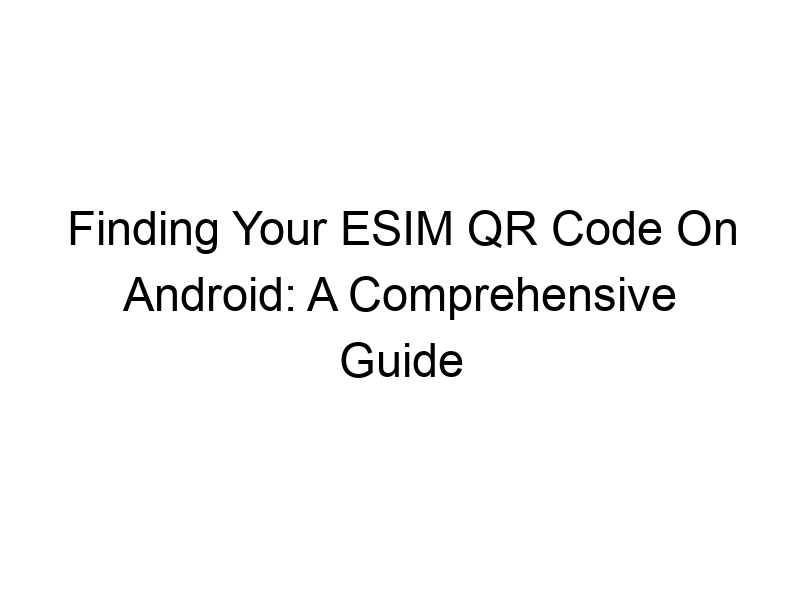Tired of juggling physical SIM cards? eSIMs offer a seamless digital alternative, but finding that crucial QR code can be tricky. This guide will walk you through everything you need to know about locating your how to find esim qr code on android, from understanding what an eSIM is to troubleshooting common issues. We’ll cover various scenarios, providing clear instructions and practical tips for both beginners and advanced users. You’ll learn how to access your code from different sources, understand the importance of eSIM security, and even discover how to troubleshoot problems if your code isn’t readily available.
An eSIM, or embedded SIM, is a digital SIM card built directly into your Android device. Unlike traditional physical SIM cards, you don’t need to physically insert or swap them. This makes switching between carriers
or adding multiple lines much easier.
How Does an eSIM Work?
Your device downloads a digital profile containing your mobile plan information via a QR code. This profile is encrypted and securely stored on your device. Think of it as a digital key that unlocks your mobile connection.
Advantages of Using an eSIM
- Easy switching between carriers and plans.
- No need for physical SIM cards, simplifying travel.
- Improved security due to the digital nature.
- Potential for multiple profiles (e.g., work and personal).
Locating Your eSIM QR Code
Obtaining Your QR Code from Your Carrier
The most common way to get your eSIM QR code is directly from your mobile carrier. Most carriers provide the QR code during the online signup process. You might receive it via email or find it within their mobile app. Examples include Verizon, AT&T, and T-Mobile. Check your carrier’s website or app for specific instructions.
Checking Your Email and SMS Messages
After signing up for an eSIM, carefully review your emails and SMS messages. The QR code is often attached as an image or embedded within a link. Don’t delete these messages until you’ve successfully activated your eSIM.
Accessing Your QR Code Through Your Carrier’s App
Many mobile carriers have dedicated apps where you can manage your eSIM profile. Look for an option like “eSIM,” “SIM management,” or “Mobile plan details.” The app may provide a digital QR code or a link to download it.
Contacting Carrier Support
If you can’t find your QR code anywhere, contacting your carrier’s customer support is crucial. They can assist you in retrieving it or guiding you through the activation process.
eSIM Security and Privacy
Understanding eSIM Encryption
eSIM profiles are encrypted to prevent unauthorized access. This encryption protects your personal data and prevents others from using your mobile connection.
Safeguarding Your eSIM QR Code
Treat your eSIM QR code like any other sensitive information. Avoid sharing it with others, and don’t save it in easily accessible locations on your device. Avoid saving it on cloud storage that is not protected with password managers.
Troubleshooting eSIM QR Code Issues
What if I Can’t Find My QR Code?
If you’ve exhausted all avenues and still can’t locate your QR code, contact your carrier’s customer support immediately. They can help you troubleshoot the issue and potentially resend the code. If they are unable to locate your information, they may need to send you a physical SIM card.
My QR Code Doesn’t Scan Correctly
Ensure your device’s camera is clean and focused. Make sure you have sufficient lighting when scanning. Poor lighting or a damaged QR code may prevent successful scanning. If your carrier app allows for manual entry, this may work as a backup.
My Device Doesn’t Support eSIM
Check your device’s specifications to confirm eSIM compatibility. Not all Android devices support eSIM technology.
Comparing eSIM and Physical SIM Cards
Advantages and Disadvantages of Each
eSIMs offer convenience and flexibility, but they also have limitations. Physical SIM cards provide more familiarity but lack the ease of use offered by eSIMs.
| Feature | eSIM | Physical SIM |
|---|---|---|
| Convenience | High | Low |
| Flexibility | High | Low |
| Security | High | Moderate |
| Compatibility | Dependent on device | Wide compatibility |
Setting Up Your eSIM
Step-by-Step Guide to eSIM Activation
- Open your device’s settings and locate the SIM management or network settings.
- Select “Add mobile plan” or a similar option.
- Scan the QR code provided by your carrier.
- Follow the on-screen instructions to complete the activation process.
- Restart your device to ensure the eSIM is properly activated.
Troubleshooting Common Setup Issues
If you encounter errors during setup, check your internet connection, ensure you’re scanning the correct QR code, and try restarting your device. If problems persist, contact your carrier.
Using Multiple eSIM Profiles
Managing Multiple Lines on Your Android
Many Android devices support multiple eSIM profiles. This allows you to have both a personal and business line active on the same device.
Switching Between eSIM Profiles
Your device’s settings will usually provide options to switch between activated eSIM profiles. This allows for seamless transition between your lines based on the context.
The Role of VPNs in eSIM Security
What is a VPN and How Does it Enhance Security?
A Virtual Private Network (VPN) creates an encrypted connection between your device and the internet. Think of it as a secure tunnel for your data, protecting your online activity from prying eyes. Examples of popular VPNs include ProtonVPN, Windscribe, and TunnelBear.
Using a VPN with an eSIM
Using a VPN with an eSIM enhances your online privacy and security. This added layer of protection safeguards your data even when using public Wi-Fi networks.
Recommendations for Secure VPN Services
- ProtonVPN (Strong security, paid and free options)
- Windscribe (Good free tier, paid plans offer more features)
- TunnelBear (User-friendly interface, reliable service)
eSIM and International Travel
Using eSIMs While Traveling Abroad
eSIMs are particularly useful for international travel. You can easily activate a local data plan without needing to purchase a physical SIM card in a foreign country.
Choosing the Right International eSIM Plan
Research and compare different international eSIM plans to find one that suits your needs and budget. Consider data allowances, roaming charges, and coverage areas.
Frequently Asked Questions
What is an eSIM and why should I use one?
An eSIM is a digital SIM card embedded in your phone, offering simpler management and more flexibility than physical SIMs. You avoid having to swap physical SIM cards, making it perfect for travelers or those with multiple phone lines.
How do I find my eSIM QR code after purchasing it online?
Check your email confirmation, the carrier’s app, or contact their support if you can’t find it. Some providers allow you to download the QR code from your online account portal.
What happens if I lose or damage my phone with an active eSIM?
Contact your carrier immediately. They can guide you on how to suspend your service and perhaps transfer it to a new device.
Can I use an eSIM and a physical SIM card simultaneously?
This depends on your phone’s capabilities. Some phones support dual SIM functionality, allowing for both an eSIM and a physical SIM card. Consult your phone’s specifications.
Are eSIMs secure?
Yes, eSIMs utilize strong encryption to protect your data. However, you still need to be cautious about phishing and other online threats.
What are the differences between eSIM and physical SIM cards in terms of cost?
The cost of the SIM itself is negligible for an eSIM. The primary cost difference lies in the mobile plans offered by carriers. An eSIM doesn’t necessarily mean more or less cost overall. The pricing depends on the data plan.
If my eSIM isn’t working, what should I do?
Try restarting your phone, checking for network coverage, and confirming you’ve correctly activated the eSIM. Contact your carrier if problems persist. They can likely check the status of your eSIM activation or troubleshoot any issues.
Final Thoughts
Navigating the world of eSIMs can seem complex, but understanding the fundamentals of finding your eSIM QR code is the first step toward a more seamless mobile experience. Whether you’re a seasoned tech user or a complete beginner, this guide has equipped you with the knowledge and tools to manage your eSIM with confidence. Remember to always prioritize the security of your QR code and eSIM profile. Utilize reputable VPN services like Windscribe or ProtonVPN for an additional layer of online protection. Don’t hesitate to contact your carrier’s support if you face any difficulties. Embrace the convenience and flexibility of eSIM technology, and enjoy the enhanced mobile experience it offers!
Download Windscribe today and experience secure, encrypted browsing with your new eSIM!

